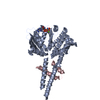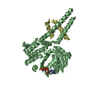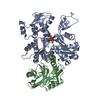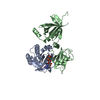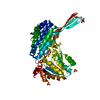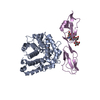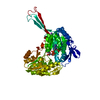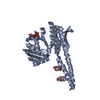[日本語] English
 万見
万見- EMDB-23270: Cryo-EM structure of the N-terminal alpha-synuclein truncation 41-140 -
+ データを開く
データを開く
- 基本情報
基本情報
| 登録情報 | データベース: EMDB / ID: EMD-23270 | |||||||||
|---|---|---|---|---|---|---|---|---|---|---|
| タイトル | Cryo-EM structure of the N-terminal alpha-synuclein truncation 41-140 | |||||||||
 マップデータ マップデータ | ||||||||||
 試料 試料 |
| |||||||||
 キーワード キーワード | N-terminal alpha-synuclein truncation / PROTEIN FIBRIL | |||||||||
| 機能・相同性 |  機能・相同性情報 機能・相同性情報negative regulation of mitochondrial electron transport, NADH to ubiquinone / neutral lipid metabolic process / regulation of phospholipase activity / negative regulation of monooxygenase activity / regulation of acyl-CoA biosynthetic process / negative regulation of dopamine uptake involved in synaptic transmission / negative regulation of norepinephrine uptake / positive regulation of glutathione peroxidase activity / positive regulation of SNARE complex assembly / positive regulation of hydrogen peroxide catabolic process ...negative regulation of mitochondrial electron transport, NADH to ubiquinone / neutral lipid metabolic process / regulation of phospholipase activity / negative regulation of monooxygenase activity / regulation of acyl-CoA biosynthetic process / negative regulation of dopamine uptake involved in synaptic transmission / negative regulation of norepinephrine uptake / positive regulation of glutathione peroxidase activity / positive regulation of SNARE complex assembly / positive regulation of hydrogen peroxide catabolic process / supramolecular fiber / negative regulation of transporter activity / mitochondrial membrane organization / negative regulation of chaperone-mediated autophagy / regulation of reactive oxygen species biosynthetic process / positive regulation of protein localization to cell periphery / regulation of synaptic vesicle recycling / negative regulation of platelet-derived growth factor receptor signaling pathway / negative regulation of exocytosis / regulation of glutamate secretion / regulation of norepinephrine uptake / response to iron(II) ion / SNARE complex assembly / positive regulation of neurotransmitter secretion / dopamine biosynthetic process / regulation of locomotion / positive regulation of inositol phosphate biosynthetic process / synaptic vesicle priming / regulation of macrophage activation / negative regulation of microtubule polymerization / synaptic vesicle transport / dopamine uptake involved in synaptic transmission / dynein complex binding / positive regulation of receptor recycling / regulation of dopamine secretion / protein kinase inhibitor activity / negative regulation of thrombin-activated receptor signaling pathway / response to type II interferon / cuprous ion binding / synaptic vesicle exocytosis / positive regulation of exocytosis / kinesin binding / positive regulation of endocytosis / mitochondrial ATP synthesis coupled electron transport / cysteine-type endopeptidase inhibitor activity involved in apoptotic process / response to magnesium ion / regulation of presynapse assembly / synaptic vesicle endocytosis / negative regulation of serotonin uptake / alpha-tubulin binding / localization / phospholipid metabolic process / supramolecular fiber organization / axon terminus / inclusion body / cellular response to copper ion / cellular response to epinephrine stimulus / Hsp70 protein binding / excitatory postsynaptic potential / response to interleukin-1 / adult locomotory behavior / negative regulation of cysteine-type endopeptidase activity involved in apoptotic process / positive regulation of release of sequestered calcium ion into cytosol / SNARE binding / fatty acid metabolic process / long-term synaptic potentiation / phosphoprotein binding / protein tetramerization / regulation of transmembrane transporter activity / microglial cell activation / synapse organization / negative regulation of protein kinase activity / regulation of long-term neuronal synaptic plasticity / protein destabilization / ferrous iron binding / tau protein binding / PKR-mediated signaling / positive regulation of protein serine/threonine kinase activity / receptor internalization / phospholipid binding / synaptic vesicle membrane / positive regulation of inflammatory response / activation of cysteine-type endopeptidase activity involved in apoptotic process / actin cytoskeleton / positive regulation of peptidyl-serine phosphorylation / actin binding / cell cortex / cellular response to oxidative stress / histone binding / growth cone / postsynapse / chemical synaptic transmission / neuron apoptotic process / negative regulation of neuron apoptotic process / amyloid fibril formation / response to lipopolysaccharide / molecular adaptor activity / oxidoreductase activity / lysosome / transcription cis-regulatory region binding 類似検索 - 分子機能 | |||||||||
| 生物種 |  Homo sapiens (ヒト) Homo sapiens (ヒト) | |||||||||
| 手法 | らせん対称体再構成法 / クライオ電子顕微鏡法 / 解像度: 3.2 Å | |||||||||
 データ登録者 データ登録者 | Xiaodan N / Ryan PM | |||||||||
| 資金援助 |  米国, 1件 米国, 1件
| |||||||||
 引用 引用 |  ジャーナル: Proc Natl Acad Sci U S A / 年: 2021 ジャーナル: Proc Natl Acad Sci U S A / 年: 2021タイトル: The N terminus of α-synuclein dictates fibril formation. 著者: Ryan P McGlinchey / Xiaodan Ni / Jared A Shadish / Jiansen Jiang / Jennifer C Lee /  要旨: The generation of α-synuclein (α-syn) truncations from incomplete proteolysis plays a significant role in the pathogenesis of Parkinson's disease. It is well established that C-terminal truncations ...The generation of α-synuclein (α-syn) truncations from incomplete proteolysis plays a significant role in the pathogenesis of Parkinson's disease. It is well established that C-terminal truncations exhibit accelerated aggregation and serve as potent seeds in fibril propagation. In contrast, mechanistic understanding of N-terminal truncations remains ill defined. Previously, we found that disease-related C-terminal truncations resulted in increased fibrillar twist, accompanied by modest conformational changes in a more compact core, suggesting that the N-terminal region could be dictating fibril structure. Here, we examined three N-terminal truncations, in which deletions of 13-, 35-, and 40-residues in the N terminus modulated both aggregation kinetics and fibril morphologies. Cross-seeding experiments showed that out of the three variants, only ΔN13-α-syn (14‒140) fibrils were capable of accelerating full-length fibril formation, albeit slower than self-seeding. Interestingly, the reversed cross-seeding reactions with full-length seeds efficiently promoted all but ΔN40-α-syn (41-140). This behavior can be explained by the unique fibril structure that is adopted by 41-140 with two asymmetric protofilaments, which was determined by cryogenic electron microscopy. One protofilament resembles the previously characterized bent β-arch kernel, comprised of residues E46‒K96, whereas in the other protofilament, fewer residues (E61‒D98) are found, adopting an extended β-hairpin conformation that does not resemble other reported structures. An interfilament interface exists between residues K60‒F94 and Q62‒I88 with an intermolecular salt bridge between K80 and E83. Together, these results demonstrate a vital role for the N-terminal residues in α-syn fibril formation and structure, offering insights into the interplay of α-syn and its truncations. | |||||||||
| 履歴 |
|
- 構造の表示
構造の表示
| ムービー |
 ムービービューア ムービービューア |
|---|---|
| 構造ビューア | EMマップ:  SurfView SurfView Molmil Molmil Jmol/JSmol Jmol/JSmol |
| 添付画像 |
- ダウンロードとリンク
ダウンロードとリンク
-EMDBアーカイブ
| マップデータ |  emd_23270.map.gz emd_23270.map.gz | 3.2 MB |  EMDBマップデータ形式 EMDBマップデータ形式 | |
|---|---|---|---|---|
| ヘッダ (付随情報) |  emd-23270-v30.xml emd-23270-v30.xml emd-23270.xml emd-23270.xml | 8.8 KB 8.8 KB | 表示 表示 |  EMDBヘッダ EMDBヘッダ |
| 画像 |  emd_23270.png emd_23270.png | 194.5 KB | ||
| Filedesc metadata |  emd-23270.cif.gz emd-23270.cif.gz | 4.7 KB | ||
| アーカイブディレクトリ |  http://ftp.pdbj.org/pub/emdb/structures/EMD-23270 http://ftp.pdbj.org/pub/emdb/structures/EMD-23270 ftp://ftp.pdbj.org/pub/emdb/structures/EMD-23270 ftp://ftp.pdbj.org/pub/emdb/structures/EMD-23270 | HTTPS FTP |
-検証レポート
| 文書・要旨 |  emd_23270_validation.pdf.gz emd_23270_validation.pdf.gz | 336.4 KB | 表示 |  EMDB検証レポート EMDB検証レポート |
|---|---|---|---|---|
| 文書・詳細版 |  emd_23270_full_validation.pdf.gz emd_23270_full_validation.pdf.gz | 336 KB | 表示 | |
| XML形式データ |  emd_23270_validation.xml.gz emd_23270_validation.xml.gz | 6.1 KB | 表示 | |
| CIF形式データ |  emd_23270_validation.cif.gz emd_23270_validation.cif.gz | 6.8 KB | 表示 | |
| アーカイブディレクトリ |  https://ftp.pdbj.org/pub/emdb/validation_reports/EMD-23270 https://ftp.pdbj.org/pub/emdb/validation_reports/EMD-23270 ftp://ftp.pdbj.org/pub/emdb/validation_reports/EMD-23270 ftp://ftp.pdbj.org/pub/emdb/validation_reports/EMD-23270 | HTTPS FTP |
-関連構造データ
- リンク
リンク
| EMDBのページ |  EMDB (EBI/PDBe) / EMDB (EBI/PDBe) /  EMDataResource EMDataResource |
|---|---|
| 「今月の分子」の関連する項目 |
- マップ
マップ
| ファイル |  ダウンロード / ファイル: emd_23270.map.gz / 形式: CCP4 / 大きさ: 64 MB / タイプ: IMAGE STORED AS FLOATING POINT NUMBER (4 BYTES) ダウンロード / ファイル: emd_23270.map.gz / 形式: CCP4 / 大きさ: 64 MB / タイプ: IMAGE STORED AS FLOATING POINT NUMBER (4 BYTES) | ||||||||||||||||||||||||||||||||||||||||||||||||||||||||||||
|---|---|---|---|---|---|---|---|---|---|---|---|---|---|---|---|---|---|---|---|---|---|---|---|---|---|---|---|---|---|---|---|---|---|---|---|---|---|---|---|---|---|---|---|---|---|---|---|---|---|---|---|---|---|---|---|---|---|---|---|---|---|
| ボクセルのサイズ | X=Y=Z: 0.83 Å | ||||||||||||||||||||||||||||||||||||||||||||||||||||||||||||
| 密度 |
| ||||||||||||||||||||||||||||||||||||||||||||||||||||||||||||
| 対称性 | 空間群: 1 | ||||||||||||||||||||||||||||||||||||||||||||||||||||||||||||
| 詳細 | EMDB XML:
CCP4マップ ヘッダ情報:
| ||||||||||||||||||||||||||||||||||||||||||||||||||||||||||||
-添付データ
- 試料の構成要素
試料の構成要素
-全体 : N-terminal alpha-synuclein truncation 41-140
| 全体 | 名称: N-terminal alpha-synuclein truncation 41-140 |
|---|---|
| 要素 |
|
-超分子 #1: N-terminal alpha-synuclein truncation 41-140
| 超分子 | 名称: N-terminal alpha-synuclein truncation 41-140 / タイプ: complex / ID: 1 / 親要素: 0 / 含まれる分子: all |
|---|---|
| 由来(天然) | 生物種:  Homo sapiens (ヒト) Homo sapiens (ヒト) |
-分子 #1: Alpha-synuclein
| 分子 | 名称: Alpha-synuclein / タイプ: protein_or_peptide / ID: 1 / コピー数: 12 / 光学異性体: LEVO |
|---|---|
| 由来(天然) | 生物種:  Homo sapiens (ヒト) Homo sapiens (ヒト) |
| 分子量 | 理論値: 10.346242 KDa |
| 組換発現 | 生物種:  |
| 配列 | 文字列: GSKTKEGVVH GVATVAEKTK EQVTNVGGAV VTGVTAVAQK TVEGAGSIAA ATGFVKKDQL GKNEEGAPQE GILEDMPVDP DNEAYEMPS EEGYQDYEPE A UniProtKB: Alpha-synuclein |
-実験情報
-構造解析
| 手法 | クライオ電子顕微鏡法 |
|---|---|
 解析 解析 | らせん対称体再構成法 |
| 試料の集合状態 | filament |
- 試料調製
試料調製
| 緩衝液 | pH: 7.4 |
|---|---|
| 凍結 | 凍結剤: ETHANE |
- 電子顕微鏡法
電子顕微鏡法
| 顕微鏡 | FEI TITAN KRIOS |
|---|---|
| 撮影 | フィルム・検出器のモデル: GATAN K2 SUMMIT (4k x 4k) 平均電子線量: 55.0 e/Å2 |
| 電子線 | 加速電圧: 300 kV / 電子線源:  FIELD EMISSION GUN FIELD EMISSION GUN |
| 電子光学系 | 照射モード: FLOOD BEAM / 撮影モード: BRIGHT FIELD |
| 実験機器 |  モデル: Titan Krios / 画像提供: FEI Company |
- 画像解析
画像解析
| 最終 再構成 | 想定した対称性 - らせんパラメータ - Δz: 4.8 Å 想定した対称性 - らせんパラメータ - ΔΦ: -1.64 ° 想定した対称性 - らせんパラメータ - 軸対称性: C1 (非対称) 解像度のタイプ: BY AUTHOR / 解像度: 3.2 Å / 解像度の算出法: FSC 0.143 CUT-OFF / 使用した粒子像数: 20867 |
|---|---|
| 初期モデル | モデルのタイプ: NONE |
| 最終 角度割当 | タイプ: NOT APPLICABLE |
 ムービー
ムービー コントローラー
コントローラー




